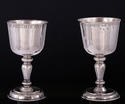 It is not until the late 17th century that the number of goldsmiths working in Glasgow began to increase. By 1689 we know of five working there who, like goldsmiths in other Scottish burghs, were now stamping their own maker's marks on their wares. For the first time Glasgow-made pieces could be identified. Glasgow goldsmiths also tried to follow those in Edinburgh and Aberdeen in complying with national laws about the purity of the silver and gold they used by adding marks to identify where pieces had been made and date-letters to show when. The Glasgow town mark was taken from the burgh's coat of arms – the tree, fish, bell and ring. Unfortunately, Glasgow stopped using annual date letters about 1710, so most 18th century Glasgow silver only carried its maker's mark and the town mark.
It is not until the late 17th century that the number of goldsmiths working in Glasgow began to increase. By 1689 we know of five working there who, like goldsmiths in other Scottish burghs, were now stamping their own maker's marks on their wares. For the first time Glasgow-made pieces could be identified. Glasgow goldsmiths also tried to follow those in Edinburgh and Aberdeen in complying with national laws about the purity of the silver and gold they used by adding marks to identify where pieces had been made and date-letters to show when. The Glasgow town mark was taken from the burgh's coat of arms – the tree, fish, bell and ring. Unfortunately, Glasgow stopped using annual date letters about 1710, so most 18th century Glasgow silver only carried its maker's mark and the town mark.
 As Glasgow began to grow and prosper more and more goldsmiths and silversmiths began to emerge. They included some extremely fine craftsmen, capable of producing elegant and fashionable wares for the tea and dinner tables of Glasgow's growing mercantile elite. Craftsmen such as Robert Brock, James Luke, Adam Graham and David Warnock made a variety of teapots, quaichs, tankards and cutlery, as well as communion cups for numerous churches in and around Glasgow. The firm of George Milne & John Campbell, which started business about 1757, advertised themselves as producing wares in the "most fashionable London taste"!
As Glasgow began to grow and prosper more and more goldsmiths and silversmiths began to emerge. They included some extremely fine craftsmen, capable of producing elegant and fashionable wares for the tea and dinner tables of Glasgow's growing mercantile elite. Craftsmen such as Robert Brock, James Luke, Adam Graham and David Warnock made a variety of teapots, quaichs, tankards and cutlery, as well as communion cups for numerous churches in and around Glasgow. The firm of George Milne & John Campbell, which started business about 1757, advertised themselves as producing wares in the "most fashionable London taste"!
 One of Glasgow's finest and most successful goldsmiths, Robert Gray, was first admitted to the Incorporation of Hammermen in 1776. He went on to make a great deal of fine neo-classical silver, earning himself the title of "Scotland's Paul Storr", a reference to the famous English silversmith (1771-1844). However, the distinctive Glasgow town mark came to an end in 1784 when national legislation demanded that all silver made in Scotland be sent to Edinburgh for hallmarking. This did not curtail the work of Glasgow craftsmen, but it was to be another thirty-five years until the city regained its own town mark.
One of Glasgow's finest and most successful goldsmiths, Robert Gray, was first admitted to the Incorporation of Hammermen in 1776. He went on to make a great deal of fine neo-classical silver, earning himself the title of "Scotland's Paul Storr", a reference to the famous English silversmith (1771-1844). However, the distinctive Glasgow town mark came to an end in 1784 when national legislation demanded that all silver made in Scotland be sent to Edinburgh for hallmarking. This did not curtail the work of Glasgow craftsmen, but it was to be another thirty-five years until the city regained its own town mark.